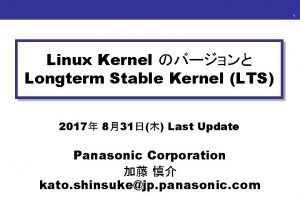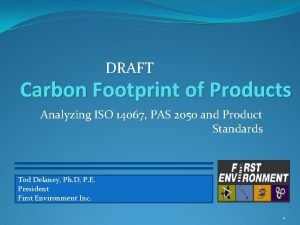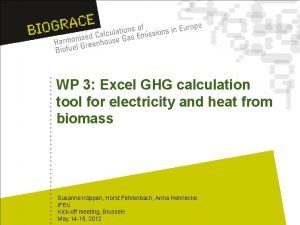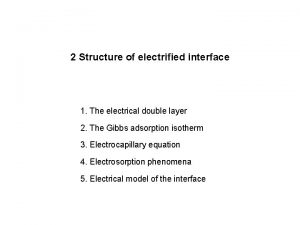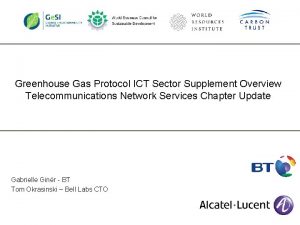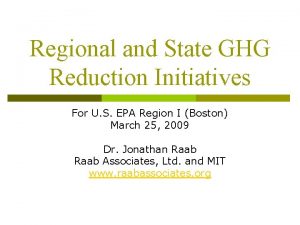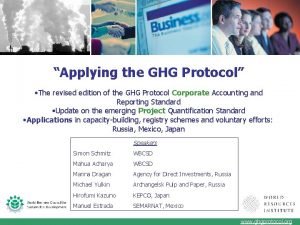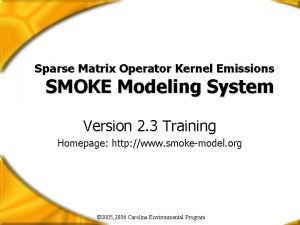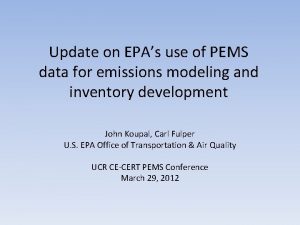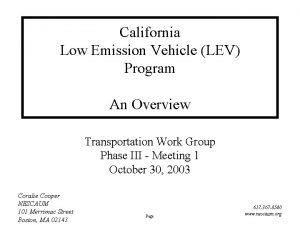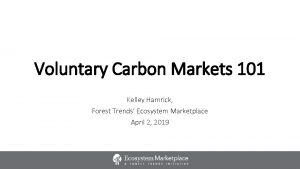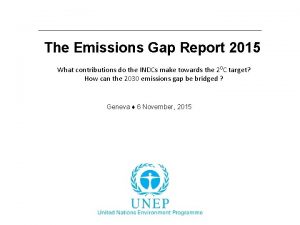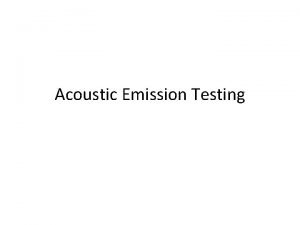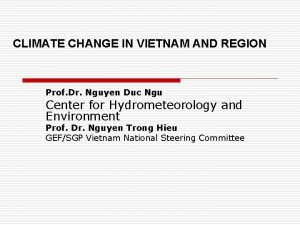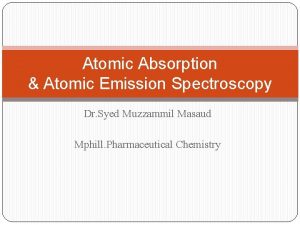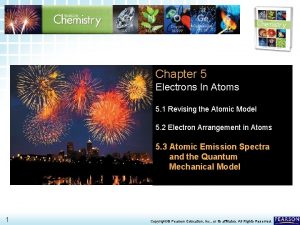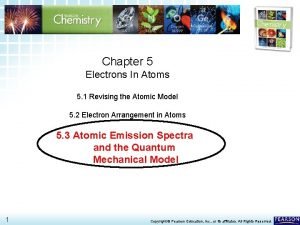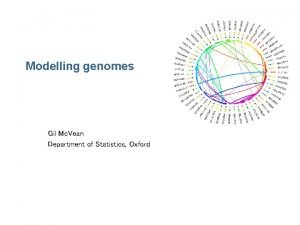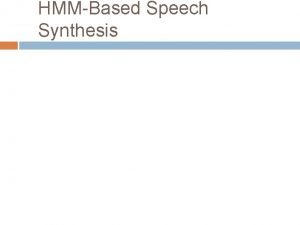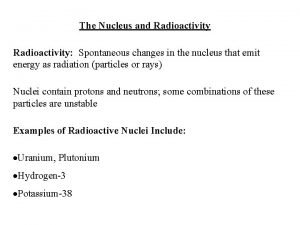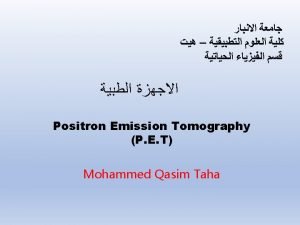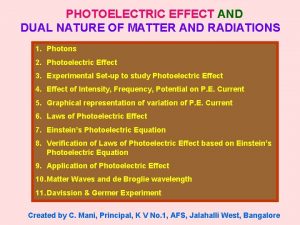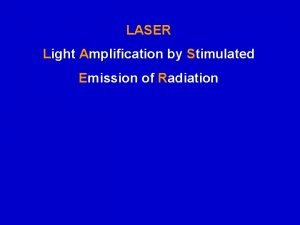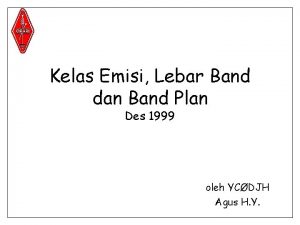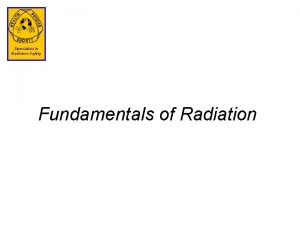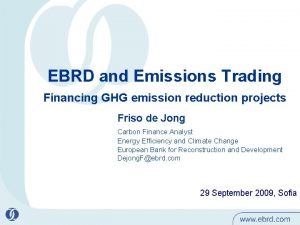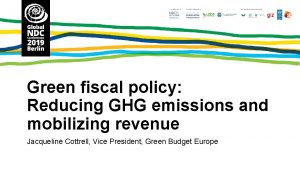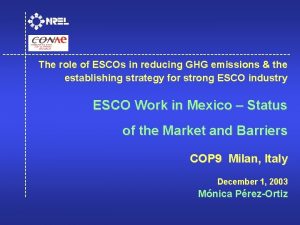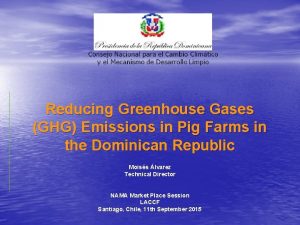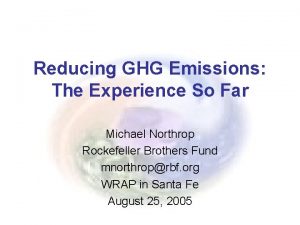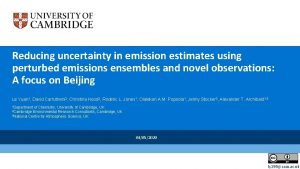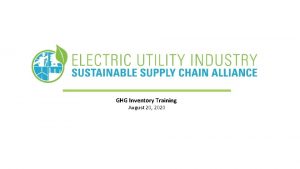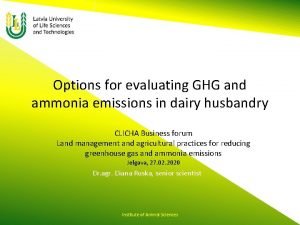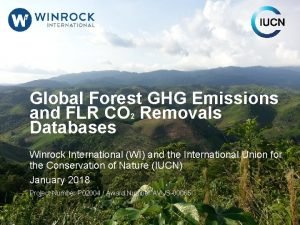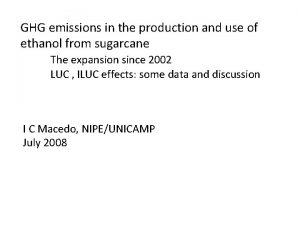Reducing GHG emissions post2012 mid and longterm emission













































- Slides: 45

Reducing GHG emissions post-2012: mid- and long-term emission reduction targets and implementation strategies Robert Tippmann, Head of Policy Advisory Services Eco. Securities Global Consulting Services 28 th UNFCCC-SB meetings, 11 June 2008

Overview • • The challenge, regulatory framework(s) and state of play Annex I countries: short-, medium- and long-term targets Measures to meet targets – measures to mitigate climate change Domestic measures Flexible mechanisms No carbon credits in the EU ETS? !. . . unlikely to go through Non-Annex I: major developing countries What is happening? Where are going? © 2008 ECOSECURITIES GROUP PLC

The challenge, regulatory framework(s) and state of play • Emissions need to peak by 2025 and reduce by 50% by 2050. Big challenge, but technically and economically feasible. • EU ETS (Phase I, III), Kyoto Protocol (I and II? ), (new post-2012 agreement) • Post-2012 regime and its elements need to be agreed on at Co. P 15 in Copenhagen in 2009 – Bali Action Plan is the road map • Annex I countries around the world have announced or adopted medium - and long-term targets © 2008 ECOSECURITIES GROUP PLC

Annex I countries: short-, medium- and long-term targets Kyoto (2008 -2012) 2020 2050 EU -8% -20% or -30% Not announced UK -12. 5% -26% to -32% -50% Germany -21% -40% Not announced Japan -6% Not announced -50% globally Canada -6% -20% -50% to -70% Australia +8% Not announced -60% N. B. Targets are all relative to 1990 levels except for Canada and Australia where they refer to 2006 and 2000 levels respectively. © 2008 ECOSECURITIES GROUP PLC

Measures to meet targets – measures to mitigate climate change Planned (continued) measures to meet new targets 1) Domestic measures 2) Flexible mechanisms (i) Emissions trading (ii) Project-based mechanisms (Additional) Measures under discussion with a view to post-2012 – Technology development and transfer – Sectoral approaches – Policy-based approaches – Financial measures and instruments © 2008 ECOSECURITIES GROUP PLC

1) Domestic measures Domestic action as a central tool to meet medium- and long-term emission reduction targets Measures: Overall reduction in energy consumption Improved energy efficiency Increased role for renewable energy sources Higher biofuel share in petrol (controversial) Introduction of transport fuel quality standards Tax incentives in the transport sector Reduced energy use in built environment © 2008 ECOSECURITIES GROUP PLC

2) Flexible Mechanisms (i) Emission trading schemes Increased role in post 2012 framework; increased linking between different ETS. - EU ETS: continued, strengthened and expanded - Japan: current voluntary ETS to be reconsidered - Canada: developing comprehensive ETS; possible NAFTA ETS - Australia: developing national ETS, drawing experience from New South West Wales GGAS. - US: Federal ETS, Liberman-Warner introduced to Senate, June 2008 © 2008 ECOSECURITIES GROUP PLC

Flexible Mechanisms (ii) Project-based mechanisms • Contemplated by all Annex I countries examined as a way to supplement domestic action. • Not all have released amount of CERs and ERUs allowed, but some did such as Canada, for example -10% of overall emission reduction efforts. © 2008 ECOSECURITIES GROUP PLC

No carbon credits in the EU-ETS? ! … unlikely to go through EU proposal to cut down almost entirely on amount of credits allowed. Reasons: • Too many credits in the market might lessen the European industry’s commitments and incentives to reduce emissions. • No or rather less CER demand puts pressure on major developing countries to cooperate in negotiations with regards to mitigation contributions. Counterarguments: 1) Reliance on credits to meet targets (in many cases). 2) Investment flows in low-carbon energy to developing countries through CDM supported by many EU policy makers. 3) Wider significance for carbon market if the CDM is damaged. 4) no CERs in EU ETS = reduced financial flow into developing countries for climate friendly projects. © 2008 ECOSECURITIES GROUP PLC

Non-Annex I: Major developing countries China, India, Brazil: Discussion on binding emission reduction targets at a certain point in time decided or measured, e. g. , against economic indicators. Positions: China: not willing to take on binding emission reduction targets India: ‘per-capita emissions will never exceed the average per-capita emissions of developed industrial economies’ Brazil: no binding emission reduction targets before the middle of the century What are they doing (so far) or planning to do? China’s Renewable Energy Law; Brazil’s Ethanol Programme; India’s new regulations in the transportation, iron and steel sectors BUT: emissions are projected to more than double in the three countries in the next 2 decades (compared to 2000 levels). Measures implemented will slow this trend, but not enough. Critics argue that many of these measures are mainly targeted to continued cash flow from the CDM. © 2008 ECOSECURITIES GROUP PLC

What is happening? Where are we going? 1. It is not a question of ‘if’ the ‘story’ continues after 2012 but rather ‘how’ 2. New targets plus EU ETS III and negotiations about KP II and post-2012 basket show that absolute targets will continue to be one of the major pillars of post-2012 mitigation efforts 3. Proven and too a large extent successful instruments such as the flexible mechanisms (emissions trading and project-based mechanisms) are here to stay beyond 2012 and will continue to play a (partly reformed) role 1. Long(er)-term and needed signals for the carbon market and investors 2. How will supplementarity and the share of project-based mechanisms compared to domestic action and other instruments play out this time? 3. Latest EU proposal unlikely to go through – in the case each Member State would allow for 10% use of CERs with increased targets overall demand would increase, for example. 4. ‘Mix or basket of approaches and instruments’ will contain more instruments, while revisiting previously discussed approaches, to allow wider participation and broader range of ways for reducing emissions as well as flexibility to join the ‘absolute targets-club’ 1. Instruments such as sectoral and technology approaches might gain more importance 2. When will (Annex I and non-Annex I) opponents join the ‘targets-club’? 5. What role will voluntary measures and markets and consumer behavioural changes play? © 2008 ECOSECURITIES GROUP PLC

THANK YOU FOR YOUR ATTENTION! Robert Tippmann Head of Policy Advisory Services, Eco. Securities GCS Tel: +39 0654 592 195 Mob: +44 (0)7950 696 644 Fax +39 0654 592 135 Email: robert@ecosecurities. com Web: www. ecosecurities. com © 2008 ECOSECURITIES GROUP PLC

Creating a global Carbon Market Linking different emissions trading schemes to the EU ETS SBSTA June 11 th 2008 Siobhan O’Keeffe

Benefits of linking Ø Expands market & increases cost-effective functioning by increasing market liquidity and diversity in marginal abatement costs − more access to low cost emissions reductions Ø Strengthens cooperation between parties with binding targets and increases incentives for others to take such targets on board Ø May serve to draw US into Kyoto regime Ø Developing a global carbon market – creating a single price on carbon eliminates competition issues Ø Links to JI/CDM enhance technology transfer to countries and involves sectors not covered by EU ETS in reduction efforts © 2008 ECOSECURITIES GROUP PLC

Methods of linking A link between various ETSs could be established in different ways: – Directly, through a global deal building on Kyoto – Directly, allowances from different ETSs fully fungible – Binding international treaty a la EU ETS, or private bilateral contracts, or political commitment to adopt and reciprocate domestic linking legislation – Indirectly, by governments acting as mediators , converting allowances – Indirectly, through acceptance of common project mechanisms © 2008 ECOSECURITIES GROUP PLC

Indirect linking via CDM/JI and AAUs 1. In the EU ETS land-use-based CDM credits currently are excluded. The type of offsets allowed in each scheme could cause problems of compatibility. 2. A major concern for offset purchasers, such as Japan and the UK, is the existence of ‘Hot Air’ from Russia and the Ukraine – could lead to collapse of EUA prices. 3. Legislation on the ‘greening’ of AAUs must also be developed © 2008 ECOSECURITIES GROUP PLC

Key design issues for linking Level of the Cap Kyoto ratification Monitoring, verification and reporting standards Method of allowance allocation System type Government Intervention (e. g. ex post adjustments, safety valve, price caps etc) © 2008 ECOSECURITIES GROUP PLC

Emissions trading schemes worldwide Canada (US) WCI USA (US) RGGI Japan Switzerland (Aus) NSW GGAS Australia New Zealand © 2008 ECOSECURITIES GROUP PLC

Switzerland Ø Swiss ETS (started beginning of 2008) rests on CO 2 tax of € 7. 60. Companies can opt out of tax by entering cap-and-trade ETS. Positives: – Both downstream trading systems covering direct CO 2 emissions from the combustion of fossil fuels. – Credits from CDM and JI projects can be used for compliance in both schemes, and the trading period is also compatible (both end in 2012) Negatives: – However, less stringent penalties - repay only the CO 2 tax - for every ton emitted since the date of exemption including interest – May restrict ability to opt out of other internal market decisions – Has an ex post adjustment likely to be rejected by EC – Lack of verified monitoring © 2008 ECOSECURITIES GROUP PLC

Japan Ø Japanese Voluntary Emissions Trading Scheme > 150 companies, awarded subsidies for energy efficiency and transition from oil. Penalties are removal of subsidies and public naming and shaming "We believe the (European style) cap and trade system is the most effective means to cut emissions, but we need to gain a consensus. We can't leapfrog. ”Japanese Environment Minister, Ichiro Kamoshita, Oct 2007 Serious concerns over linkage – Threat to environmental integrity – Subsidies obscure marginal costs and reduce efficiency – Intensity targets © 2008 ECOSECURITIES GROUP PLC

Australia Ø Detailed design still being formulated (by end of 2008) Ø New Labour government has outlined five ‘tests’ for the ETS: – Cap and trade, compatible with EU ETS, Kyoto Protocol, RGGI and eventual California ETS – To reduce emissions by 60% by 2050 – Must not endanger Australian economic competitiveness. Must also be complemented by measures to encourage tech innovation – Must share costs and benefits across industries – Must start no later than 2010 Ø Strong linking contender, though some areas for potential concern: – Support for a price cap, limited sector coverage. © 2008 ECOSECURITIES GROUP PLC

New Zealand Ø Binding cap and trade system that by 2013 will cover 6 Kyoto GHGs and all major emitting sectors (starting with forestry 2008) Ø Penalty = NZ$30 and the shortfall Ø Currently indirect linking possible via international market in Kyoto units, although direct bilateral linking remains ultimate aim Ø Primary domestic unit of trade will be NZU, fully comparable to all types of AAUs. Allows AAUs (except from sinks and nuclear), CERs and ERUs. Fear of ‘hot air’ makes AAU recognition an obstacle to EU linkage. Ø Very small ETS, so designed with international linkage in mind © 2008 ECOSECURITIES GROUP PLC

Federal US ETS 1. Several Bills in Congress and the Senate. . . 2. Most significant = Lieberman-Warner Bill (S. 2191, now S. 3036) Introduced October 2007 Aims for 71% reduction of 2005 levels by 2050 - lax Also backs nuclear offsets Went to a Senate vote 2 June 2008 – failed to progress Backed by Presidential candidates Would begin in 2012 with 4% below 2005 levels cap © 2008 ECOSECURITIES GROUP PLC

Regional Greenhouse Gas Initiative (RGGI) 1. 10 state cap & trade scheme covering electricity generation, launch 2009 2. Stabilisation of emissions by 2015, and 10% reduction by 2019 3. Trading with carbon credits outside the US allowed, although restricted to give US allowances preference 4. Obstacles: – Threat of leakage, as a sub-Sovereign scheme – Ineligible entity under international treaty law – Less stringent targets 5. Benefit: Potentially v. large scheme, with good potential benefits for EU ETS participants © 2008 ECOSECURITIES GROUP PLC

In conclusion Clear benefits to creating a harmonised global carbon market But different design features can impact on the practicality and desirability of linking different schemes Unlikely for linking to occur in the short term, but in the longer term following on from negotiation, harmonisation of features and basic trial and error a expanded carbon market will appear © 2008 ECOSECURITIES GROUP PLC

Thank You Siobhan O’Keeffe Project Manager, Commercialisation +44 1865 202 635 siobhan. okeeffe@ecosecurities. com www. ecosecurities. com © 2008 ECOSECURITIES GROUP PLC

Mobilizing untapped potential: Developing mitigation projects in the rural, agricultural and forestry sectors Colin Moore SBSTA, 11 June 2008

Content The Importance of the Rural and Land Use Sectors for Climate Change Project Types and their Status Potential Revenues from SLM Potential for Combined Mitigation / Adaptation © 2008 ECOSECURITIES GROUP PLC

Role of the rural and land use sectors Significant importance: among the so-called dirty seven 1. Energy sector: 25%* 2. Industry: 20% 3. Transport: 13% 4. Forestry: 17% 5. Agriculture: 14% 6. Households: 8% 7. Waste and sewage: 3% * Of 2004 emissions (IPCC report 2007) © 2008 ECOSECURITIES GROUP PLC

Importance of forestry and agricultural sector Main emissions from deforestation © 2008 ECOSECURITIES GROUP PLC Main emissions methane, nitrous oxides

Potential project types © 2008 ECOSECURITIES GROUP PLC

Status of project types CDM (of 1033 registered) Forestry: Agriculture: Energy efficiency: © 2008 ECOSECURITIES GROUP PLC 1 project registered 83 projects registered 15% of all projects, 12% of CERs> project developers often not from rural context

Importance of the land use and rural sector • Potential for emission reductions and carbon credit generation still not fully captured in the agricultural, rural and land use sectors. - Africa, India, S. E. Asia • Measures in this sector allow for the cost-effective reduction of emissions while often also delivering development and biodiversity co-benefits. © 2008 ECOSECURITIES GROUP PLC

Small scale biogas - Nepal Installation of 1. 9 million anaerobic digesters (150, 000 latrines installed) Captures CH 4 from wastewater and animal waste CH 4 burned for cooking Benefits: – Emission reductions – Biodiversity – Bio slurry displaces chemical fertiliser – Improved sanitation © 2008 ECOSECURITIES GROUP PLC

Solar cookers – Aceh, Indonesia Installation of 1000 solar cookers One cooker delivers reduction of 3. 5 t/CO 2 Benefits: – Emission reductions (avoids deforestation) – Biodiversity – Improved air quality – Improves quality of life (time) © 2008 ECOSECURITIES GROUP PLC

Biomass heating - Moldova Improved efficiency and fuel switch in rural communities Refurbishment of heating systems (40 -60% 80 -90% efficiency) Switch from coal to compressed wheat straw bales Benefits: – Emission reductions – Local employment © 2008 ECOSECURITIES GROUP PLC

SFM – Scolel Te’, Chiapas, Mexico Carbon sequestration into forest and agricultural systems Farmers design sequestration project to meet own needs – Pastures to plantations – Restoration of degraded forest – Agroforestry Verified by Plan Vivo Benefits: – Emission reductions – Sustainable livelihoods – Biodiversity © 2008 ECOSECURITIES GROUP PLC

Potential carbon revenue from SLM Land area under agricultural or forest use decreased by 6. 9 million ha between 1990 – 2000 (FAO 2004) – 50% lost completely for productive activity (e. g. Degradation) – 50% converted to settlements, pastures* SLM results in savings of 1 -3 t. CO 2/ha/yr * Oldeman (1992) © 2008 ECOSECURITIES GROUP PLC

Carbon revenue from SLM Carbon revenue potential for SLM (in million US$ over 10 years) Emission reductions US $1 US $3 US $5 US $15 1 t. CO 2 e/ha 35 104 173 518 3 t. CO 2 e/ha 104 311 518 1, 552 5 t. CO 2 e/ha 173 518 863 2, 588 © 2008 ECOSECURITIES GROUP PLC

Adaptation Rural poor most vulnerable to climate change (IPCC, Stern) – Decrease in agricultural productivity – Severe weather events – Water shortages – Disease – Migration – Conflict over resources © 2008 ECOSECURITIES GROUP PLC

Adaptation Projects must address human, economic and social vulnerabilities Implementation of measures to: – Safeguard water resources – Implement disaster management – Diversify economic activity – Protect health © 2008 ECOSECURITIES GROUP PLC

Adaptation in the land use sector Specific measures could include: – Protecting and enhancing agriculture and forestry – Protecting natural resources and ecosystems – Protecting coastal zones Synergies: Mitigation & Adaptation! © 2008 ECOSECURITIES GROUP PLC

Unlocking potential in the land use and rural sector Structured and systematic approach to engage concerned stakeholders (both public & private) to promote mitigation / adaptation activities on the ground. What’s needed: • Improve framework conditions • Mobilise facilitation measures for projects (technical and financial) © 2008 ECOSECURITIES GROUP PLC

Conclusions Promising and important sector, yet underdeveloped Strong sustainability co-benefits of projects in the land use and rural sectors Offers the potential for combined mitigation and adaptation First steps are being done but need to intensify actions, measures and awareness © 2008 ECOSECURITIES GROUP PLC

THANK YOU! Colin Moore Consultant, Eco. Securities Email: colin. moore@ecosecurities. com © 2008 ECOSECURITIES GROUP PLC
 Glucose versus glycogen
Glucose versus glycogen Iodine test reaction for carbohydrates
Iodine test reaction for carbohydrates Glucose seliwanoff test
Glucose seliwanoff test Kernel lts
Kernel lts Thomas silverstein
Thomas silverstein Reducing vs. non-reducing sugars
Reducing vs. non-reducing sugars Iso 14067 vs ghg protocol
Iso 14067 vs ghg protocol Ghg protocol ict sector guidance
Ghg protocol ict sector guidance Ghg calculator excel
Ghg calculator excel Ghg exercise
Ghg exercise Ghg+
Ghg+ Ghg protocol ict sector guidance
Ghg protocol ict sector guidance U.ghg
U.ghg Ghg protocol revised
Ghg protocol revised Volkswagen ethical dilemma
Volkswagen ethical dilemma Sparse matrix operator kernel emissions
Sparse matrix operator kernel emissions Diesel emissions denver
Diesel emissions denver Sources of nox emissions
Sources of nox emissions Parts of a sperm cell
Parts of a sperm cell Pems emissions modeling
Pems emissions modeling Flame test results table
Flame test results table Lev 2 emissions
Lev 2 emissions State of the voluntary carbon markets 2017
State of the voluntary carbon markets 2017 Un emissions gap report
Un emissions gap report Kinematic equations examples
Kinematic equations examples Using citys heat reduce emissions
Using citys heat reduce emissions Acoustic emission testing applications
Acoustic emission testing applications Ghs emissions
Ghs emissions Particulates can be removed from smokestack emissions by
Particulates can be removed from smokestack emissions by Difference between absorption and emission spectrum
Difference between absorption and emission spectrum Atomic emission spectra and the quantum mechanical model
Atomic emission spectra and the quantum mechanical model Atomic emission spectra and the quantum mechanical model
Atomic emission spectra and the quantum mechanical model Emission and absorption spectra grade 12
Emission and absorption spectra grade 12 Transition and emission probability
Transition and emission probability Transition and emission probability
Transition and emission probability Cobalt-60 nuclear decay equation
Cobalt-60 nuclear decay equation What is the symbol for an alpha particle
What is the symbol for an alpha particle Positron emission
Positron emission Einstein equation for photoelectric emission is
Einstein equation for photoelectric emission is Microwave amplification by stimulated emission of radiation
Microwave amplification by stimulated emission of radiation Metastable state
Metastable state Stimulated emission
Stimulated emission Stimulated emission
Stimulated emission Bandplan tingkat siaga pada band vhf
Bandplan tingkat siaga pada band vhf Bread toasting: gas formation color change light emission
Bread toasting: gas formation color change light emission Partial periodic table
Partial periodic table



